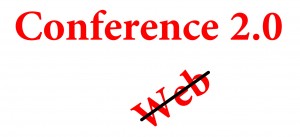Conference 2.0

But first, what’s Conference 1.0?
Conference 1.0
Conference 1.0 is characterized by:
- A small organizing group predetermines conference programs.
- Distinctions between presenters (teachers) and attendees (learners).
- A few speakers, at most, dominate sessions.
- Some combination of general and breakout sessions.
- Long, uninterrupted broadcast content.
- Networking opportunities are relegated to meals & social events outside the program sessions.
Amazingly, after no change for three centuries, the last thirty years have seen the rise of a different kind of conference.
Conference 2.0
Conference 2.0 is characterized by:
- Attendees determine programs, schedules, and activities.
- The blurring of teacher and learner as fixed roles; a teacher at one moment may be a learner the next.
- “The people formerly known as the audience” actively participate and contribute to sessions.
- A wide range of session formats: small group discussions, Ignite & Pecha Kucha, simulations, workshops, etc., coupled with few or no general sessions.
- Frequent participatory learning opportunities for attendees break up long sessions.
- Conference designs that directly facilitate, support, and encourage connections and networking between attendees.
The move to Conference 2.0 will be much slower than the transition from Web 1.0 to 2.0, because Conference 1.0 has been our dominant modality for adult face-to-face learning for so long, and it’s hard to change entrenched culture. And yet, year by year, assisted by the impact of the rise of online, Conference 2.0 designs have become better known, and their advantages experienced by more and more people.
Not one of the 500 most popular websites today is a Web 1.0 design. I believe that, over time, a similar transition from Conference 1.0 to 2.0 will occur. Whether it takes five years or a hundred years is up to you.
What are you doing to prepare for the demise of Conference 1.0? Do you organize conferences, but haven’t experienced Conference 2.0 yet? What are you waiting for?
